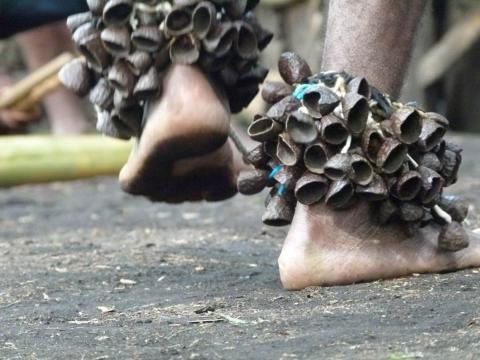ESSAY: Nicolas Molé and Yumi Danis
By Ruth McDougall
Artlines | 3-2017 | September 2017
Nicolas Molé has quickly developed an international reputation, working across media such as video, television, animation, drawing and sculpture. Born and educated in France, Molé relocated to New Caledonia in 2010 to connect with his extended family and his Kanak heritage on his father’s side. His ambitious practice engages with this heritage and its contemporary articulation.
Ils vous regardent (They look at you) 2015 was commissioned by the Gallery as part of the Yumi Danis (We Dance) project for ‘The 8th Asia Pacific Triennial of Contemporary Art’ (APT8). Focused on the role of performance in Melanesia, this collaborative project saw Molé working with a diverse group of dancers and musicians from Papua New Guinea, Fiji, Vanuatu, New Caledonia, West Papua and the Solomon Islands to develop a work that contextualised their practice for an international audience. Molé’s final installation comprises an animated forest projected onto a wall drawing, and a traditional village hut in which footage of the dancers is screened. The empty space at the centre of the installation represents the clearing found in most Melanesian villages, which is surrounded by verdant forest in which the dynamic forces of life and the spirit world abound.
It is fitting that, with its eloquent articulation of Kanak public space, Molé’s work is the first to be acquired through the generous bequest of the late architect Jennifer Taylor, who spent years researching and documenting the historical and contemporary architecture of the South Pacific.1 The Taylor bequest will enable the Gallery to support contemporary artists such as Molé.
The animated forest environment of Ils vous regardent begins in black and white and, much like the creation story of the Kanak peoples of Lifou, under the sea. A single spotlit, bright orange fish moves slowly in and around the plant forms, circling the installation space. As the fish completes its circuit, light fully illuminates the surrounding landscape revealing a forest of shadowy textured trees. Four Melanesian figures playfully move in and around this landscape, watching and responding to the audience captured in the village clearing. The animation culminates with each of the four figures embracing a tree through which the coloured life force of the forest pulses. Eventually the figures merge with the trees, and the whole scene, which is dotted with hundreds of watching eyes, erupts into colour.
In Kanak culture, trees are used for medicine and magic. Energy flows from them into both the human world and spirit world. Here, Molé engages with this force and the importance of ancestors (represented by the four figures), who are always watching over the living to make sure that we are careful in what we do.
During APT8's opening weekend, Kanak curator Emmanuel Kasarhérou, Deputy Director of Heritage and Collections at the Museé du Quai Branly — Jacques Chirac, Paris, recounted that:
Melanesia is an archipelago of cultures. It is like looking at a forest with lots of different things. You can’t name everything because it is too diverse. But, then after a while you if you sit still, you observe, you try to feel what the people who have been there before you can tell you. What you can’t see. Then you see something that gives sense to all the diversity.2
With Ils vous regardent, Nicolas Molé engages his audience in an immersive experience that emphasises the importance of the relationship between the living and the ancestral realms. Pausing to engage with this perspective helps us approach the diversity of cultures, languages and customs comprising Melanesia. Using sophisticated technologies, Molé brings to age-old beliefs and customs a new form of expression and life.
Endnotes
- See Jennifer Taylor and James Connor, Architecture in the South Pacific: The Ocean of Islands, Editions Didier Millet Pte Ltd, Singapore, 2014.
- Emmanuel Kasarhérou, in 'The Choreography of Yumi Danis', APT8 public programs, 21 November 2015, accessed 14 November 2018.
Connected objects
Metadata, copyright and sharing information
About this story
- Subject

